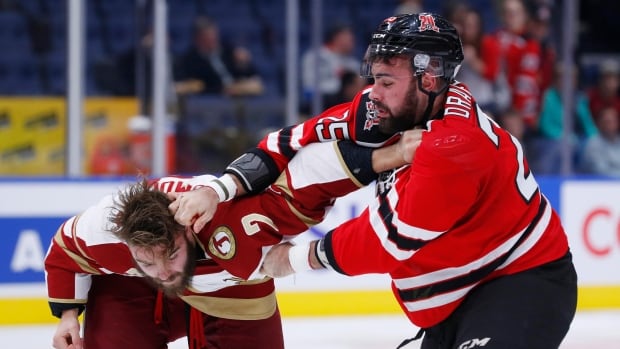To fight or not to fight? Disagreement on Quebec Major Junior Hockey League ban | CBC News
“I proved to my coach that I can score a goal. Now I have to prove to him that I can fight.”
That’s what was going through Dean Bergeron’s head on Aug. 15, 1987, when he was 17.
The teenager was getting set to start his second season in the Quebec Major Junior Hockey League (QMJHL). The Cataractes de Shawinigan were holding its training camp and anybody could be cut.
During a scrimmage, Bergeron locked eyes with an opposing player.
“We looked at each other and we knew what we had to do, so we dropped the gloves,” he told CBC News.
“It was the last time that I wore my skates and the last time that I could walk.”
New rule forbids fighting
Bergeron shared his story following a vote from QMJHL owners.
They’ve agreed to add a new rule to its rulebook “which specifies black-and-white that fighting is forbidden in our league.”
The ban is expected to take effect in June, ahead of the 2023-24 season — a good move, Bergeron says.

“As an adult, as owners, as coaches, as managers, we need to protect our young players,” he said.
After that training camp fight nearly 36 years ago , Bergeron was taken to hospital and told his spinal cord had been severed.
“All the reality changed. I was not a hockey player anymore,” he said.
“I was the poor guy that had an accident and that would be in a wheelchair for the rest of his life.”
Bergeron went on to become a renowned wheelchair racer – winning ten medals in all at the Paralympics, but hockey was his first love.
“After so many years, we now know the consequences of the fights,” he said.
“Maybe not as bad as mine, finishing in a wheelchair, but I’m pretty sure that there are many players that went through this league that are still injured mentally or physically by these fights.”

Junior players ‘not as skilled at protecting themselves’
Blaine Hoshizaki spends his days in a lab at the University of Ottawa, investigating the relationship between impacts during sporting competitions and brain damage.
In hockey, there is more than one way to receive contact to the head: Falling and hitting it on the ice, getting hit by the puck and fighting.
“The real challenge around fighting is that you’re going to get repetitive head trauma,” Hoshizaki said.
He points out, as 16 to 20 year olds , junior hockey players are at a greater risk.
“One, they don’t have a lot of skill yet because they’re just learning the game of hockey, so they’re not as skilled at protecting themselves,” Hoshizaki said.
But that’s not his biggest concern.
“[Head trauma] really does interfere with their ability to learn their academics and it influences their emotional state, things that teenage boys are not particularly good at to begin with,” Hoshizaki said.
“So when you add the trauma to the picture that becomes even more challenging.”
Fighting ban ‘is not going to save these guys’
Not everybody agrees with the new ruling.
“I’m always going to defend fighting because that’s what I did for a living,” said Georges Laracque, who played both in the Q and the NHL and was considered an enforcer.
“If there wasn’t fighting in junior hockey, maybe I wouldn’t have played in the NHL.”
But Laracque, like others who defend fighting, notes that he isn’t advocating for violence or all-out brawls. Still, he says fighting has a role.
“Taking fighting out of the game is not going to save these guys from concussions,” he said. “What’s going to happen is more cheap shots.”
Riley Cote, a former junior and NHL player who was also known as an enforcer on the ice, shares that opinion.
“I’m all for player safety but I also understand why fighting exists in hockey and it’s not just for sheer entertainment,” said Cote, who now hosts a hockey podcast called Nasty Knuckles.
Cote says players know when an enforcer opposing them is on the ice and that acts as a deterrent for taking cheap shots, because they don’t want to have to fight him.
“There is an accountability, where they know if they cross that line, they’re going to have to deal with it, so it does keep some sort of peace” he said.
Cote also worries about removing fighting in the junior leagues when there is no plans to do the same in the NHL.
“It puts them in a vulnerable situation,” Cote said.
“Having zero experience [with fighting] and then all of a sudden you are going into pro hockey and you’ll end up fighting a grown man who has some experience, and the outcome is going to be a lot worse.”
Bergeron though, doesn’t agree and says the Q has made the right decision, even if, he says, it took too long.
“I was hurt badly in a fight, it took 37 years to arrive at this point,” he said.
“But I want to salute the decision of the Quebec league.”
For all the latest Sports News Click Here

